(Purely personal views as always, based on over two decades of research and publications inside and outside Romania)
2014 marks the 25th anniversary of the collapse of communism in central and eastern Europe–Poland, Hungary, East Germany, Czechoslovakia, Bulgaria, and Romania. This series looks at 25 things I have learned about the events of the Romanian Revolution of December 1989. The numbering is not designed to assign importance, but rather–to the extent possible–to progress chronologically through those events.
Significance: Among those Ceausescu regime officials who were involved in the elimination of evidence of regime repression in Timisoara–and of the bodies of murdered Timisoara demonstrators–there are those whose names and roles are relatively well-known (Nicolae Ghircoias)…and those whose names and roles are lesser known (Dan Voinea). Interestingly, a number of these officials found themselves in a position after 22 December 1989 where they could continue to cover up the role of Securitate and Militia units in December 1989, in Timisoara, Bucharest, and elsewhere.
The Case of Nicolae Ghircoias…before and after 22 December 1989
Confirm afirmatiilor medicului chirurg Nicolae Constantinescu, sus-numitul Tripon Cornel a fost ranit prin impuscare in zona hotel Negoiu din Bucuresti. Medicii de spitalul Coltea au solicitat Procuraturii instrumentarea acestor cazuri. Colonel Ghircoias, fost sef al directiei cercetari penale a Securitatii, i-a adunat pe toti indivizii care erau acuzati ca sint teroristii, facindu-i disparuti.
Florin Mircea Corcoz si Mircea Aries, “Terorist ascuns in Apuseni?” Romania Libera , 21 august 1992, p. 1, p. 3.
for confirmation suggesting Cornel Tripon’s arrest under suspicion of being a “terrorist” (28 December 1989, Hotel Negoiu, Bucuresti) during the December 1989 events, see http://www.danbadea.net/wp-content/uploads/2009/12/img036.jpg ; for confirmation that Ghircoias himself was (later) (re-) arrested, see http://www.danbadea.net/wp-content/uploads/2009/12/img043.jpg .
for the suggestion that Tripon’s status as a member of the Militie was merely a cover mechanism see,
“La internarea in spital, militianul Cornel Tripon a prezentat un buletin pe care avea trecuta ca adresa de domiciliu str. Academiei 24. Aceeasi adresa de domiciliu (fictiv) era trecuta in buletinul mai multor ofiteri de la UM 0666. Militianul ranit a fost ridicat chiar a doua zi din spital si transportat, se pare, la o unitate spitaliceasca a Ministerului de Interne.”
from Romulus Cristea, 20 decembrie 2006, http://www.romanialibera.ro/special/reportaje/salvarile-nu-erau-pentru-raniti–80867
Bullets, Lies, and Videotape:
The Amazing, Disappearing Romanian Counter-Revolution of December 1989[1]
by Richard Andrew Hall, Ph.D.
Standard Disclaimer: All statements of fact, opinion, or analysis expressed are those of the author and do not reflect the official positions or views of the Central Intelligence Agency (CIA) or any other U.S. Government agency. Nothing in the contents should be construed as asserting or implying U.S. Government authentication of information or CIA endorsement of the author’s views. This material has been reviewed by CIA to prevent the disclosure of classified information.
I am an intelligence analyst for the Central Intelligence Agency. I have been a CIA analyst since 2000. Prior to that time, I had no association with CIA outside of the application process. [Submitted 19 November 2009; PRB approved 15 December 2009]
Part I
His name was Ghircoias…Nicolae Ghircoias.
And in Romania in December 1989 and January 1990, Nicolae Ghircoias was a very busy man.
We know, officially, of Nicolae Ghircoias’ actions in the last days leading up to the fall of the regime of communist dictator Nicolae Ceausescu on 22 December 1989, as a result of what he and others said at a trial later in January 1990. In bureaucratic parlance, Colonel Nicolae Ghircoias, was the Director of the Criminalistic Institute of the Militia’s [Police’s] General Inspectorate. In colloquial terms, in December 1989 it appears that this amounted to being something of a “cleaner,” or “fixer,” the kind of guy who could make unpleasant things—such as corpses—go away, without leaving a trace.
After regime forces opened fire on anti-regime protesters in the western city of Timisoara on 17 and 18 December 1989, Colonel Ghircoias was dispatched to recover the corpses of those with gunshot wounds from the city’s morgue. The unautopsied cadavers of 43 demonstrators were stolen from the morgue in the dead of night and then transported to the outskirts of the capital Bucharest by refrigerated truck, where they were cremated.[2] Ghircoias was also in charge of collecting and destroying the hospital records and any other incriminating material that might indicate not just the death, but also the life of those who had perished—the official explanation for the disappearance of these citizens was to be that they had fled the country, thus taking their documents with them. In other words, Colonel Nicolae Ghircoias’ job was primarily, it seems, the destruction of evidence.[3]
[For a discussion of Ghircoias’s activities in Timisoara before 22 December, please see the following:
and in the journal Mortality, no. 15 (1) 2010, Marius Rotar, “The Red Mask of Death: The Evil Politics of Cremation in Romania in December 1989.” pp. 1- 17.]
COLONEL GHIRCOIAS MAKES THE ROUNDS OF BUCHAREST’S HOSPITALS
Unofficially, we also know of Colonel Ghircoias’ exploits after the Ceausescu regime collapsed on 22 December 1989, exploits for which he was not charged at his trial and for which he has never been charged. Of the 1,104 people killed and 3,352 people injured during the December 1989 bloodshed, 942 of them were killed and 2,251 wounded after Nicolae and Elena Ceausescu fled power on 22 December 1989. At the time, personnel of the communist regime’s secret police—known as the Securitate—and allied foreign mercenaries fighting to restore the Ceausescu regime—collectively christened “the terrorists”—were thought to be the primary source behind the post-22 December bloodshed.
It was in this context, that doctors from Bucharest’s various main hospitals recall Colonel Ghircoias’ sudden, unannounced appearances during the last days of December 1989 and first days of January 1990. Professor Andrei Firica of the Bucharest “Emergency Hospital” recounted in a 2004 media interview largely the same details he had conveyed to the press in the summer of 1990. According to Firica, some 15 to 20 suspected terrorists had been interned at the “Emergency Hospital” in varying states of medical distress. He says he made a small file of the medical situations of these patients. A Militia colonel, whom he later was to see in [prisoner] stripes on TV as a defendant in the Timisoara trial—i.e. fairly clearly Ghircoias—came one day and counseled him to keep nosy foreign reporters away from the beds of the “terrorists,” stating ominously that “these were just terrorist suspects and he [Dr. Firica] didn’t want to wake up one day on trial for having defamed someone”! The colonel later came and loaded the wounded terrorist suspects onto a bus and off they went. Firica maintains the files he kept on the terrorist suspects “of course, disappeared.” He noted, however, that he asked his son, who had studied theater and film at university, to film the terrorists tied down to the hospital beds, and he claims he gave copies of this cassette to the Procuracy.[4]
[In viewing these photos, witness what Constantin Fugasin recounted in “Unde ne sint teroristii?” Zig-Zag, in 1990, based in part on an interview with Dr. Andrei Firica:
At the Emergency Hospital 13 suspected of being what we call terrorists were interned. Among these a few were definitely foreign, even though all had Romanian papers. Two clearly had ‘Mongoloid’ (‘Asiatic’) features (one stated that his mother was Romanian, while his father was from Laos), while four others were Arabs. Nevertheless, they spoke Romanian very well. Doctor Nicolae Staicovici, who worked a time in Egypt and who treated them for a time spoke with them. At a moment, he formed a question in Arabic. One of the injured responded to him perfectly. All were well-built, one was a ‘mountain of a man.’ He said nothing, although he probably had terrible pains. There were also two terrorists who were not wounded. One arrived at night, under some pretext. Those on guard suspecting him, immobilized him. He had on three layers of clothing and several ids. They tied him to the stretcher, but although he appeared rather frail, at a given moment he ripped the restraints off.[6]]
[Dr. Andrei Firica, 2004: From a diagnostic perspective, those who maintain that the terrorists didn’t exist are telling an outrageous lie…In the Emergency Hospital, people were brought who were shot with precision in the forehead, from behind, just a few yards in the crowd of demonstrators, such people who did this can only be called terrorists…[8]]
–
Dr. Nicolae Constantinescu, chief surgeon at the Coltea Hospital, also was paid the honor of a visit by Colonel Ghircoias during these days:
I remember that on 1 or 2 January ’90 there appeared at the [Coltea] hospital a colonel from the Interior Ministry, who presented himself as Chircoias. He maintained in violent enough language that he was the chief of I-don’t-know-what “criminalistic” department from the Directorate of State Security [ie. Securitate]. He asked that all of the extracted bullets be turned over to him. Thus were turned over to him 40 bullets of diverse forms and dimensions, as well as munition fragments.
To the question of whether he informed the Military Procuracy?
Of course, I announced the Prosecutor’s Office, and requested an investigation [of those shot in the revolution]. For example, when I showed them the apartment from where there were was shooting during the revolution, on the fourth floor of the ‘Luceafarul’ cinema, the prosecutors told me that they sought to verify it and uncovered that there was a Securitate ‘safehouse’ there and that was it.
In 1992, I signed along with other doctors, university professors, renowned surgeons, a memorandum [see page 5 (below) for an article apparently linked to the memorandum] addressed to the Prosecutor General in which we requested an investigation regarding the wounded and dead by gunfire. Not having received any response, after six months I went there to ask what was going on. They told me they were working on it, and they showed me two or three requests and that was it. One of the prosecutors took me into the hallway and told me “I have a child, a wife, it is very complicated.” He asked me what I thought I was doing…I lit back into him, I told him I wasn’t just any kind of person to be blown off.
I showed him the x-rays of those who were shot, I showed him the bullets in the liver. The x-rays exist, they weren’t my invention, I didn’t just dream all this up to demand an investigation! I told them that there are some people who wish to find out the truth and they signed a memo to the Procuracy and they aren’t just anybody, but doctors with experience, experts in the field. In vain, we requested ballistics tests and other research, in vain we presented forms, documents, x-rays, studies. They did not want to undertake a serious investigation.[9]
(English) Cited in The Romanian Revolution for Dum-Dums
Dr. Nicolae Constantinescu, surgeon at Coltea Hospital: “I remember that on 1 or 2 January ’90 there appeared at the [Coltea] hospital a colonel from the Interior Ministry, who presented himself as Chircoias. He maintained in violent enough language that he was the chief of a department from the Directorate of State Security [ie. Securitate]. He asked that all of the extracted bullets be turned over to him. Thus were turned over to him 40 bullets of diverse forms and dimensions, as well as munition fragments. I didn’t hear anything back from Chircoias or any expert. Those who made the evidence disappear neglected the fact that there still exist x-rays and other military documents that I put at the disposition of the [Military] Prosecutor.”
( http://www.romanialibera.ro/a113826/revolutia-5-000-de-victime-nici-un-vinovat.html)
Bucuresti, Spitalul Coltea: “Pe data de 1 sau 2 ianuarie 1990 a aparut la spital un colonel Chircoias, de la Interne cred”
Prof. univ. dr. Nicolae (Nae) Constantinescu, membru al Academiei de Medicina si al Academiei Oamenilor de Stiinta. Medic chirug la Spitalul Coltea.
– Ce s-a intamplat cu cartusele extrase chirurgical din ranile pacientilor? Erau niste probe care ar fi putut lamuri anumite aspecte…
– Pe data de 1 sau 2 ianuarie 1990 a aparut la spital un colonel Chircoias, de la Interne cred. Acest Chircoias a fost judecat si condamnat mai tarziu intr-un proces la Timisoara in legatura cu revolutia.
Chircoias, care sustinea sus si tare ca ar conduce nu stiu ce sectie criminalistica din Directia Securitatii Statului, a cerut gloantele extrase. Acestea, vreo 40 la numar, i-au fost date de un medic care era secretar de partid la IMF. Tin minte ca erau gloante de diverse forme, de diferite dimensiuni.
Procurori timorati
– Ati sesizat Parchetul Militar? Ati cerut sa se faca o ancheta in legatura cu cei impuscati la revolutie?
– Bineinteles, am anuntat Parchetul, am cerut o ancheta. De exemplu, cand le-am aratat apartamentul de unde s-a tras la revolutie, de la etajul 4, de la cinematograful “Luceafarul”, procurorii mi-au zis ca au facut verificarile si au depistat ca acolo era o locuinta conspirativa a Securitatii si atat. In anul 1992 am semnat alaturi de alti medici, profesori universitari, chirurgi de renume, un memoriu pe care l-am adresat Parchetului General si prin care am solicitat sa se faca o ancheta cu privire la ranitii si mortii prin impuscare. Neprimind nici un raspuns, dupa sase luni m-am dus la Parchet sa intreb ce se intampla. Mi s-a raspuns ca se lucreaza, mi-au aratat doua-trei avize puse pe colturile cererii si atat. Unul dintre procurori m-a luat cu el pe un coridor si mi-a spus ca “are copil, are nevasta, e foarte complicat…”. Ma intreba pe mine ce sa mai faca… Am izbucnit, le-am spus ca nu sunt un om care sa fie, asa, aburit cu una, cu doua. Le-am aratat radiografiile celor impuscati, le-am aratat gloante in ficat. Radiografiile existau, nu erau inventiile mele, nu mi se nazarise asa, dintr-o data sa cer ancheta! Le-am spus ca niste oameni doresc sa afle adevarul si ca cei care au semnat memoriul catre Parchet nu sunt niste persoane oarecare, ci medici cu experienta, somitati in materie. Degeaba am solicitat expertize balistice sau alte cercetari, degeaba am prezentat acte, documente, radiografii, lucrari. Nu se dorea sa se faca o ancheta serioasa.
Miercuri, 20 Decembrie 2006 Romania Libera
Nici acum nu-mi dau seama cum am putut sa operez nonstop timp de trei zile
Screen Capture of a registry presented by Dr. Nicolae Nae Constantinescu in TVR documentary by Toma Roman Jr. mentioning an atypical bullet with cap (varf) retezat extracted from a patient on 23 December 1989 and later “collected” by Ghircoias.
In early March 1990, Agence France Presse reported the declared findings of surgeons in Bucharest, attesting to the fact that many of those wounded on 21-22 December 1989 in Bucharest had been shot with exploding bullets, DUM-DUM bullets. [Significantly, a slew of military prosecutors, among them General Dan Voinea, General Romeo Balan, and General Teodor Ungureanu have attempted to deceive Romanians in the years since by denying or avoiding mention of the existence and use of DUM-DUM munitions in December 1989.]
Lt. Gnl. Traian Oancea, chief of surgery in part of the Central Military Hospital in Bucharest, and Dr. Nicolae “Nae” Constantinescu, chief of surgery at the Coltea Hospital, discussed this at a meeting of the Society of Surgeons in Bucharest.
|
|||||||||||||||||
|
|
|
[1]For some of my previous publications on this topic, see Richard Andrew Hall:
Hall 2008 http://homepage.mac.com/khallbobo/RichardHall/pubs/romrevfordumdums042108tk.html,
Hall 2006 http://homepage.mac.com/khallbobo/RichardHall/pubs/Voineaswar091706.html,
Hall 2005 http://homepage.mac.com/khallbobo/RichardHall/pubs/checkmate040405.html,
Hall 2004 http://homepage.mac.com/khallbobo/RichardHall/pubs/doublespeak%20romania%203-2004.html,
Hall 2002 http://homepage.mac.com/khallbobo/RichardHall/pubs/romania%20securitate%205-2002.html,
Richard Andrew Hall, “Theories of Collective Action and Revolution: Evidence from the Romanian Transition of December 1989,” Europe-Asia Studies 2000, no. 6 (September 2000).
Richard Andrew Hall, “The Uses of Absurdity: The ‘Staged-War’ Theory and the Romanian Revolution of December 1989,” East European Politics and Societies vol 13, no. 3 (Fall 1999) (University of California Berkeley Press).
[2] For a good discussion of this in English, which explains how cremation practices were at odds with Romanian burial traditions, see the article entitled “The Red Mask of Death: The Evil Politics of Cremation in Romania 1989,” in the journal Mortality, no. 15 (1).
[3]For more information online, see, for example, http://ro.wikipedia.org/wiki/Nicolae_Ghircoia%C5%9F, http://ro.wikipedia.org/wiki/Opera%C5%A3iunea_Trandafirul, http://www.romanialibera.ro/a51078/cine-a-organizat-furtul-cadavrelor-din-morga-spitalului-judetean.html, http://www.timisoara.com/newmioc/53.htm, http://www.timisoara.com/newmioc/67.htm. Even the 1994 SRI report admits that confusion surrounding the identity of those who were cremated stems from Ghircoias’ burning—after the flight of the Ceausescus on 22 December—of all relevant documents he had seized from the Timisoara county hospital http://www.ceausescu.org/ceausescu_texts/revolution/raportul_sri11.htm. Thus, it seems appropriate to say Ghircoias’ job involved making things disappear…
[4]Professor Andrei Firica, interview by Florin Condurateanu, “Teroristii din Spitalul de Urgenta,” Jurnalul National, 9 March 2004, online edition, cited in Hall, “Orwellian…Positively Orwellian” http://homepage.mac.com/khallbobo/RichardHall/pubs/Voineaswar091706.html. For similar accounts, see Florin Mircea Corcoz si Mircea Aries, “Terorist ascuns in Apuseni?” Romania Libera, 21 August 1992, p. 1–“Colonelul Ghircoias, former director of the Securitate’s penal investigative unit, brought together the individuals accused of being terrorists and made them disappear”; Andreea Hasnas, “Reportajul unui film cu TERORISTI,” Expres, no. 10 (6-12 aprilie 1990), p. 5; Constantin Fugasin, “Unde ne sint teroristii?” Zig-Zag, 1990.
[5] Screen capture from http://www.dailymotion.com/video/x7rp6b_revolutia-romana-2225-dec1989-part_shortfilms posted by Alexandru2006.
[6] Significantly this video is in direct contradiction and contests the claims of the Sorin Iliesiu who maintains that “General Dan Voinea has said clearly: The terrorists did not exist. Those who seized power lied to protect the real criminals….The diversion of the ‘terrorists’ has been demonstrated by [the] Justice [System], not a single terrorist being found among the dead, wounded or arrested (Sorin Iliesiu, “18 ani de la masacrul care a deturnat revoluţia anticomunistă,” 21 December 2007, http://www.romanialibera.com/articole/articol.php?step=articol&id=6709). For a discussion, see Hall 2008.
[7] Screen capture from http://www.dailymotion.com/video/x7rp6b_revolutia-romana-2225-dec1989-part_shortfilms posted by Alexandru2006.
[8] Professor Andrei Firica, interview by Florin Condurateanu, “Teroristii din Spitalul de Urgenta,” Jurnalul National, 9 March 2004, online edition.
[9] Dr. Professor Nicolae Constantinescu, interview by Romulus Cristea, “”Nici acum nu-mi dau seama cum am putut sa operez nonstop timp de trei zile,” Romania Libera, 20 December 2006, online edition.
——————————————————————————————————————————————————————————————————
What evidence was Ghircoias so interested in collecting from the hospitals?
No researcher has previously attempted to track and aggregate the discussion of atypical ammunition, to include exploding dum-dum bullets, that were used in the maiming and killing of demonstrators in Romania in December 1989. Here we talk about their use prior to the flight from power of Nicolae and Elena Ceausescu at 12:09 on 22 December 1989. Romanian prosecutors, mostly notably former military prosecutor General Dan Voinea, have refused to acknowledge the existence and use of dum-dum bullets in December 1989–and yet the documents of the military procuracy itself contradict them. (Voinea’s “findings” are invoked as the basis for the chapter about December 1989 in the so-called Tismaneanu Commission Final Report). Below, evidence from the testimonies of demonstrators, next of kin, and doctors in Timisoara.
Timisoara Decembrie 1989 / Timisoara December 1989, regia/directed by – Ovidiu Bose Pastina, , imaginea/camera – Doru Segal, Sahiafilm 1991
Who has given evidence that exploding dum-dum bullets were used in the killing and maiming of people in Timisoara before and/or after 22 December 1989:
1) Doctors and medical personnel who operated on and/or treated, and/or saw those who died or were wounded
2) Military personnel, who were in the streets in these days, including military officers
3) Relatives of the dead and wounded, some of whom were in the streets themselves, in sworn declarations for the Military Prosecutor immediately after the December 1989 events or in sworn testimony in the so-called Timisoara Trial of 1990-1991
4) People who were wounded in December 1989, some of whom were sent abroad for follow-up treatment and who were told by those foreign doctors what type of bullet they believed they had been shot with, in sworn declarations for the Military Prosecutor immediately after the December 1989 events or in sworn testimony in the so-called Timisoara Trial of 1990-1991.
5) Civilians who overheard during 17-19 December the discussion among regime forces of the use of such bullets
6) A former Securitate officer who went public after 1989 (Roland Vasilevici) and an unnamed former USLA recruit
Ora 23.00: La morga Spitalului Judetean, sub comanda colonelului Ghircoias, incepe operatiunea de sustragere a cadavrelor. Au fost ridicate 43 de cadavre cu acordul conducerii spitalului si al procurorului general adjunct Gheorghe Diaconescu. Toate cadavrele fusesera “incizate” pentru a li se extrage gloantele. Au fost transportate apoi la Bucuresti, cu o autoizoterma, pentru a fi incinerate.
Dan Badea 1991 evz.ro Ceausescu ultimele zile 21 decembrie 1999
|
|
In nopţile dramatice ale lui Decembrie 1989, medicii de la spitalele din Bucureşti au extras sute de gloanţe din trupurile demonstranţilor care manifestau împotriva regimului totalitar din România. Firesc ar fi fost ca aceste probe şi dovezi ale represiunii sângeroase să fie preluate cu un proces verbal şi folosite pentru identificarea celor care au tras în ţintele umane.
Din nefericire aceste probe delicte au dispărut. Toate mărturiile medicilor, dar şi ale celor care au studiat fenomenul îl incriminează pe colonelul Nicolae Ghircoiaş, cel care a colindat prin spitalele din Capitală şi a preluat gloanţele extrase din răniţi sau morţi, devenite ulterior de negăsit.
De altfel, colonelul Ghircoiaş fusese însărcinat să facă dispărute şi cadavrele manifestanţilor ucişi la Timişoara după 16 decembrie 1989.
Procesul de la Timisoara (III): Audierea martorului Rodica Novac, directorul Direcţiei Sanitare Timiş (13 iunie 1990)
Posted by romanianrevolutionofdecember1989 on September 30, 2011
[as always, purely personal views based on purely personal research and publications over the past two decades]
Thanks to Miodrag Milin (and ASOCIAŢIA MEMORIALUL REVOLUŢIEI 16-22 DECEMBRIE 1989, TIMIŞOARA), the tapes of the Timisoara trials of 1990-1991 have been transcribed and made available to the public. These transcripts are highly valuable for the researcher of the December 1989 Romanian Revolution. To my knowledge, much of this information has never made it into the public domain, and much of the most important information has definitely not.
Below, the witness Rodica Novac states that in the Morgue “there were several horror scenes, even for a medic such as myself…it will remain a nightmarish memory, the wounds of these explosive bullets [gloante explozive] have remained with me in particular…” (p. 653)
When reading the courtroom testimony below, keep in mind here the unambiguous rejection by military prosecutor Dan Voinea of the use of dum-dum bullets in December 1989:
Dan Voinea: There were no victims (people who were shot) from either vidia bullets or dum-dum bullets. During the entire period of the events war munitions were used, normal munitions that were found at the time in the arsenal of the Interior Ministry and the Defense Ministry. The confusion and false information were the product of the fact that different caliber weapons were used, and therefore, the resulting sound was perceived differently. (General Dan Voinea, interview by Romulus Cristea, “Toti alergau dupa un inamic invizibil,” Romania Libera, 22 December 2005, online edition.)
[Are these court documents available at the website of the IICCMER? Or the website of Asociatia 21 decembrie 1989? No! Thankfully, however, they are available on this site http://www.banaterra.eu/romana/files/procesul_de_la_timisoara_volumul_IV_cuprins_0.pdf ]. The following is from Volume IV.]
Rodica Novac’s claim is corroborated elsewhere by four other medical officials on call during the Timisoara repression. First, in Romanian, by Dr. Atanasie Barzeanu, then in Hungarian by three doctors (Vladimir Fluture, Csaba Ungor, and Andras Goga) present and performing surgery in Timisoara hospitals from 17-19 december 1989 who recount separately their discovery of dum-dum exploding bullets among the bullets with which demonstrators arriving at the hospital had been shot. december 1989: temesvari orvosok, dum-dum golyok, es a roman forradalom
http://ro.wikipedia.org/wiki/Opera%C8%9Biunea_Trandafirul
Operațiunea Trandafirul
| Acest articol sau această secțiune are bibliografia incompletă sau inexistentă. Puteți contribui prin adăugarea susținerii bibliografice pentru afirmațiile conținute. |
Operațiunea Trandafirul, devenită apoi Acțiunea Vama, s-a desfășurat în zilele de 18 și 20 decembrie 1989, în cadrul acțiunilor de reprimarea a revoluției din decembrie 1989.
43 de cadavre ale celor împușcați mortal la demonstrațiile din Timișoara în zilele de 16 și 18 decembrie, dar și ale unor răniți executați în Spitalul Județean Timiș (SJT), au fost ridicate de la morga acestui spital și transportate la București, unde au fost incinerate în Crematoriul Cenușa.
Scopul era ștergerea urmelor masacrului de la Timișoara. Dispariția cadavrelor urma să fie explicată susținând că persoanele respective au părăsit fraudulos țara, fugind în statele vecine.
Cuprins
Persoane implicate
Ordinul a venit din partea Elenei Ceaușescu, care era tot timpul în contact direct cu soțul ei aflat în vizită oficială în Iran. Din conducerea superioară de partid și de stat au mai contribuit Tudor Postelnicu și Emil Bobu.
Conducătorii operațiunii:
- General-locotenent Constantin Nuță, adjunct al ministrului de interne, șef al Inspectoratului General al Miliției (IGM) (1978-1989), care cunoștea tot planul și avea și sarcina aplicării lui,
- gen. Velicu Mihalea, adjunct al șefului IGM,
- gen. Emil Macri, șef al Direcției contrainformații economice din Departamentul Securității Statului (DSS).
Alți ofițerii superiori de Securitate și Miliție implicați erau:
- Filip Teodorescu, locțiitor al șefului Direcției contraspionaj din DSS,
- Traian Sima, șef al Securității Timiș,
- Nicolae Ghircoiaș, director al Institutului de Criminalistică al IGM, cu sediul la București,
- Ion Deheleanu, șef al Miliției județene Timiș,
- locotenent-colonel Ion Corpodeanu, locțiitor al șefului Miliției Județene Timiș,
- Ion Baciu, șef al Direcției Economice din IGM,
- col. Petre Moraru[1], locțiitor al șefului IGM,
- col. Tudor Stănică (a fost de față la emiterea ordinelor, dar nu a participat personal în acțiune),
- Un rol important a avut și medicul chirurg, general de Securitate Mircea Octavian Ignat, care lucra la SJT.
Din dispoziția procurorului general al RSR Nicolae Popovici, au fost trimiși la Timișoara adjunctul procurorului general Gheorghe Diaconescu. (A mai fost detașat și procurorul Ovidius Păun, dar el nu a mai ajuns în oraș.) Din partea Direcției Sanitare județene a fost implicată dr. Rodica Novac.
Pentru ridicarea cadavrelor și încărcarea lor în autovehicul, Ion Corpodeanu i-a desemnat pe ofiterii și subofițerii de miliție: mr. Gheorghe Avram, mr. Iosif Veverca, cpt. Laurențiu Preda, cpt. Tiberiu Grui, cpt. Eugen Mișea și lt. major Eugen Peptan.
Colonelul Nicolae Ghircoiaș avea sarcina să coordoneze activitatea de selectare a cadavrelor în morga spitalului județean din Timișoara, întrucât el vizitase spitalul și mai înainte și avea informații despre cauzele morții. Scopul era selectarea cadavrelor celor care au participat la acțiunile de protest de cele ale bolnavilor care au murit din cauze patologice. După îmbarcarea celor 43 de cadavre, așezate în saci de plastic, în mașina autofrigorifică, colonelul Ghircoiaș a organizat și desăvârșit și furtul și distrugerea evidențelor compromițătoare ale spitalului.[2]
Conform planului, cadrele Miliției din Timișoara implicate in acțiune nu trebuiau să cunoască ordinul că morții transportați la București vor fi incinerați.
Unul dintre participanții la acțiunea Vama, maiorul de miliție Dumitru Sorescu, a fost înaintat după Revoluție la gradul de general și numit chestorul șef al Poliției române.[3]
Operațiunea „Trandafirul”
În seara zilei de 17 decembrie, col. Corpodeanu a fost chemat de gen. Nuță, care i-a ordonat să se ocupe de transportul unor cadavre împușcate de la morga Spitalului Județean Timiș, devenită neîncăpătoare, la Institutul Medico-Legal (IML) din București. La ora aceea erau 56 de cadavre în morgă și, deși alimentarea cu curent electric nu era întreruptă, se afirma că nu funcționează camerele frigorifice.
Col. Deheleanu, șeful lui Corpodeanu, a ordonat formarea unei echipe de la secția judiciară a Miliției județene, de supravegherea îndeplinirii ordinului urmând să se ocupe col. Ghircoiaș.
Cronologia evenimenelor din zilele de 18-19 decembrie în Timișoara
- Ora 8:00: procurorul-șef adjunct Gheorghe Diaconescu era prezent la Direcția Sanitară, la dr. Rodica Novac, împreună cu col. Ghircoiaș.
- Ora 9:00: În zona spitalului și în curtea acestuia a fost desfășurat un întreg dispozitiv de apărare format din securiști și milițieni sub comanda mr. Veverca și mr. Dragoș. În același timp, s-a interzis orice vizită în spital, fiind permisă numai intrarea personalului medico-sanitar pe bază de legitimație.
- Ora 10:00: au sosit și generalii Nuță și Mihalea.
- În urma vizitei la spital, procurorul general adjunct Gh. Diaconescu cere col. Ghircoiaș să trimită la SJT echipa pentru operațiunea de verificare a celor decedați.
- Ora 14:00: autopsierul Traian Bodonea aduce la morgă saci de nailon.
- Ora 17:00: procurorul Diaconescu se prezintă la Direcția Sanitară.
- Ora 18:00: doctorul Ovidiu Sorin Golea, directorul Spitalului Județean, este vizitat de col. Sima Traian și col. Ghircoiaș.
- Ora 19:00: Gen. Nuță vorbește la telefon cu col. Petre Moraru și cu col. Ion Baciu (care se aflau la București), și le ordonă să ia măsurile necesare pentru paza unui transport de la Timișoara la București. În termeni codificați, era vorba de „primirea unui camion de la Timișoara cu diferite colete sosite din străinătate ca ajutoare, și care trebuie distruse la București, la Vama Antrepozite”. Col. Ion Baciu se deplasează, tot din ordinul gen. Nuță, la procurorul general Nicolae Popovici, care îl aștepta, și l-a primit imediat, spunându-i că l-a sunat gen. Nuță și i-a cerut să-l sprijine în distrugerea unor colete ce urmau a fi trimise de la Timișoara.
- Ora 19:00: dr. Golea a ridicat cheia de la morgă. Pe geamurile saloanelor sau camerelor spitalului cu orientare spre intrarea morgii au fost așezate pături, pentru a bloca vizibilitatea din interior.
- Ora 23:00: la cererea col. Ghircoiaș și col. Corpodeanu, dr. Golea deschide morga. Cinci ofițeri de miliție conduși de col. Ghircoiaș, medicii legiști (prof. dr. Traian Crișan și conf. dr. Milan Dressler) și procurorii civili încep identificarea și selectarea cadavrelor. Cele selectate sunt introduse în saci de plastic.
- Ora 23:30: Începând cu această oră circulația bolnavilor prin spital era totalmente interzisă.
- Dorel Cioacă, șofer pe autoizoterma 21-TM-2701, angajat al Complexului de Creștere și Îngrășare a Porcilor COMTIM, este convocat din dispoziția inginerului Dan Rotariu, la sediul Miliției județene, unde căpitanul Valentin Ciucă[4] îl invită în birou, și îi spune că poate să doarmă până la noi ordine.
- Ora 0:45: În jurul acestei ore, din ordinul lt. col. Corpodeanu, au fost îndepărtate din fața intrării și din curtea spitalului trupele, astfel autoizoterma (la volanul căreia era cpt. Valentin Ciucă) a putut intra până la ușa morgii. A mai sosit și o Dacia 1310 albă (nr. 1-TM-236, condusă de șoferul șefului Miliției Județene, plut. adj. Alexandru Kocic), în care erau doi milițieni de la Inspectoratul Județean Timiș.
- Ora 1:00: luminile din curtea spitalului au fost stinse, pentru ca bolnavii din spital să nu poată observa acțiunea.
- Ora 1:30: cei șase ofițeri desemnați de Corpodeanu – Iosif Veverca, Gheorghe Avram, Eugen Mișea, Laurențiu Preda, Tiberiu Grui și Eugen Peptan – au început încărcarea în autoizotermă a cadavrelor (denumite în continuare „colete”) indicate de Ghircoiaș.
- Ora 4:15: A luat sfârșit operațiunea de îmbarcare a cadavrelor în autoizotermă, care părăsește curtea spitalului, însoțită de autoturismul Dacia amintit mai sus. Luminile din curtea spitalului au fost aprinse din nou, iar trupele ce asigurau dispozitivul de apărare și-au reluat pozițiile inițiale.
- De la Spitalul Județean Timiș sunt ridicate registrele de consultații, de internări, procesele-verbale de constatare a decesului și fișele de mișcare ale bolnavilor, împachetate în două colete și predate col. Ghircoiaș. Ulterior, unele registre au fost înapoiate, din ele lipsind însă anumite file.
- Ora 5:20: șoferul Dorel Cioacă, care dormea în biroul căpitanului Ciucă, este trezit.
- Ora 5:45: autoizoterma pornește spre București pe ruta Sibiu – Râmnicu Vâlcea – Pitești, fiind escortată de Dacia albă.[5]
- Cele două autovehicule au fost așteptate la km 36 de pe autostrada București-Pitești de o echipă de ofițeri condusă de Ion Baciu. Din momentul preluării transportului, operațiunea primea indicativul „Acțiunea Vama”.
Acțiunea „Vama”
Conform ordinului gen. Nuță, autoizoterma cu „colete” a fost preluată pe 19 decembrie, la km 36, de o echipă condusă de col. Baciu și formată din lt.-col. Petre Marin, mr. Dumitru Sorescu[6], Teodor Bagu, Marin Șerban și subofițerii Valerică Gorgarea și Florin Stanciu. Această echipă a schimbat-o pe cea veche, din Timișoara, subofițerul Florin Stanciu preluând conducerea autoizotermei. Cei de la Timișoara și-au continuat drumul cu Dacia albă, și au fost cazați la hotelurile Astoria și Cerna, unde căpitanul Dan Fediuc le-a rezervat câte o cameră cu două paturi. Înainte de plecarea de la km 36, numerele de înmatriculare, atât al Daciei albă cât și al autoizotermei, au fost înlocuite cu număre de înmatriculare de București, primite de la Direcția Circulație (al cărei șef nu a fost inițiat în acțiune).
În jurul orei 17 autoizoterma și echipa de însoțitori din București au ajuns la crematoriul „Cenușa” din București, unde au fost primite de Gheorghe Ganciu, director al Administrației Cimitirelor din București (cu sediul la Cimitirul Belu),[7] colonel de Securitate în rezervă, fost subordonat al gen. Macri, și de administratorul Crematoriului Cenușa, Iosef Emilian Zamfir, care era de asemenea ofițer de Securitate trecut în rezervă.
Ei au întrerupt alte operații de incinerare care erau în curs, și au început incinerarea cadavrelor sosite de la Timișoara. Pentru reușita acțiunii, celor 5 fochiști[8] le-a fost dat câte un plic cu 2000 de lei, și aceștia au început lucrul imediat, fără obiecțiuni. Col. Moraru a trimis 6 ofițeri pentru asigurarea pazei.
În jurul orei 18:00 fost începută descărcarea cadavrelor, incinerarea începând aproape imediat și continuând toată noaptea. Ultimul cadavru a fost descărcat pe 20 decembrie în jurul orei 4:00, și atunci autoizoterma a părăsit crematoriul. Incinerarea a fost finalizată în jurul orei 8:30.
În jurul orei 10:00 col. Baciu a raportat col. Moraru încheierea acțiunii, care l-a trimis la crematoriu pe șoferul Nuțu Dorel Marian cu o autodubă, în care au fost încărcate cele 4 tomberoane cu cenușă și transportate pe raza localității Popești-Leordeni, Ilfov, unde conținutul lor a fost deversat într-o gură de canal.
După Revoluție, col. Baciu, lt.col. Petre Marin și mr. Dumitru Sorescu au făcut câte un raport despre acțiunea desfășurată de ei[9], și aceste rapoarte au fost prezentate în seara zilei de 24 decembrie inginerului Marian Gostin, reprezentantul CFSN, care se afla la IGM, apoi predate ministrului apărării naționale, gen. Nicolae Militaru.
Numele morților
În momentul operațiunii, la morga SJT se aflau 56 de cadavre, din care au fost sustrase 43. Din acestea 8 erau neidentificate, dar după Revoluție s-a reușit stabilirea identității a 4 dintre ele.
Lista morților:[10]
- Andrei Maria (muncitoare UMT, împușcată în SJT)
- Apró Mihai (lăcătuș auto)
- Balogh Pavel
- Balmus Vasile
- Bărbat Lepa
- Banciu Leontina (muncitoare la AEM)
- Belehuz Ioan
- Belici Radian
- Caceu (Kacsó?) Margareta (muncitoare la Institutul Politehnic)[11]
- Choroși (Kőrösi?) Alexandru
- Cruceru Gheorghe
- Carpin Dănuț
- Csizmarik Ladislau
- Ciobanu Constantin
- Wittman Petru
- Nagy Eugen
- Ferkel Șuteu Alexandru
- Florian Antoniu Tiberiu
- Gîrjoabă Dumitru Constantin (electrician, împușcat în SJT)[12]
- Hațegan Petru
- Iosub Constantin
- Iotcovici Gheorghe Nuțu
- Ewinger Slobodanca
- Ianoș Paris
- Luca Rodica (muncitoare la Coop. „Încălțămintea”)
- Lăcătuș Nicolae
- Munteanu Nicolae Ovidiu
- Miron Ioan (pensionar CFR, împușcat în SJT)
- Motohon Silviu
- Mardare Adrian
- Otelita Aurel
- Opre Gogu
- Osman Dumitru
- Radu Constantin
- Sporer Rudolf Herman
- Stanciu Ioan
- Sava Angela Elena
- Zăbulică Constantin
- Zornek Otto
- cadavru neidentificat
- cadavru neidentificat
- cadavru neidentificat
- cadavru neidentificat
Note
- ^ S-a sinucis în arest, la 31 ianuarie 1990.
- ^ România Liberă: Cine a organizat furtul cadavrelor din morga Spitalului Judetean?, 19 decembrie 2005.
- ^ Vezi știrea apărută în Jurnalul Național din 17 ianuarie 2005, și preluată de Hotnews.
- ^ El va însoți autoizoterma până la km 36, apoi va ajunge în București.
- ^ Șoferul său de schimb era cpt. Valentin Ciucă, care a rămas în cabină.
- ^ Mr. Dumitru Sorescu, ajuns chestor principal, a fost numit mai târziu șeful Inspectoratului General al Poliției Române. Vezi știrea din Jurnalul Național din 17 ianuarie 2005, preluată de Hotnews.ro.
- ^ Gheorghe Ganciu a fost asistat de subalternul său, Ciupagea Grigorie.
- ^ Întrucât la crematoriul Cenușa nu erau decât 3 fochiști – Mihai Mititelu, Ștefan Nicolae Bocioagă și Grigor Cîmpean -, doi muncitori – Gheorghe Zîmbroianu și Gheorghe Iordan – au fost trimiși de la alte două cimitire din București.
- ^ Col. Baciu pretinde că pe 22 decembrie și-a trimis raportul col. Moraru, dar acesta nu l-a primit.
- ^ Lista a fost publicată în Jurnalul National, 28 septembrie 2004, articol preluat de Hotnews.ro, dar ortografia numelor s-ar putea să conțină greșeli.
- ^ Împreună cu Caceu Margareta a fost împușcată și sora ei, Caceu Mariana Silvia, dar corpul ei nu a fost ars.
- ^ Vezi articolul din JN, preluat de Hotnews.
Surse
- Gen. de brigada Gheorghe Florea, col. Ion Constantin, gen de brigada Marin Lazăr, col. Vasile Lepăduși, prof. Vladimir Alexandrescu și coordonator generalul de divizie Ion Pițulescu: „Șase zile care au zguduit România. Ministerul de Interne, decembrie 1989. Pledoarie pentru istorie”, vol. I., București, 1995.
Lectură suplimentară
- Un risc asumat: Timișoara, decembrie 1989, Filip Teodorescu, Editura Viitorul Românesc, 1992
- Timișoara în arhivele “Europei Libere”, Radio Free Europe, Editura Fundația Academia Civică, 1999
http://www.procesulcomunismului.com/marturii/fonduri/mmioc/curteasup/docs/0215cada.htm#_ftnref2
http://atomic-temporary-3899751.wpcomstaging.com/2010/12/17/timisoara-17-decembrie/
In English and Romanian, see, for example, the following on the episode mentioned above
The mask of the red death: The evil politics of cremation in Romania in December 1989
Marius Rotar
Mortality: Promoting the interdisciplinary study of death and dying, 1469-9885, Volume 15, Issue 1, 2010, Pages 1 – 17
http://www.informaworld.com/smpp/content~db=all~content=a919672850
 a Crematorium in Bucharest of 43 bodies belonging to people who were killed in Timi
a Crematorium in Bucharest of 43 bodies belonging to people who were killed in Timi oara on the 17 December 1989 during the riots against the Communist regime. The Romanian communist authorities aimed to delete the traces of the repression in Timi
oara on the 17 December 1989 during the riots against the Communist regime. The Romanian communist authorities aimed to delete the traces of the repression in Timi oara. The explanation given to the families of the people cremated, namely that they had fled from communist Romania, also served this purpose. This incident reveals the ways in which politics and death merged in communist Romania, and it presents a typical case of what Douglas Davies calls the evil politics of cremation.
oara. The explanation given to the families of the people cremated, namely that they had fled from communist Romania, also served this purpose. This incident reveals the ways in which politics and death merged in communist Romania, and it presents a typical case of what Douglas Davies calls the evil politics of cremation.Keywords: communism; revolution; cremation; scandals
http://mariusmioc.wordpress.com/2010/09/15/a-inceput-constructia-bisericii-popesti-leordeni/#more-8198
http://mariusmioc.wordpress.com/2010/12/08/tatulici-tatomir-povestea-timisorii-13-furtul-cadavrelor/
—————————————————————————————————————————————————————————————————–
Less well-known and certainly never acknowledged is the presence of military prosecutor Dan Voinea at the Popesti-Leordeni crematorium near Bucharest on the morning of 20 December 1989. It has always been something of a mystery–and Voinea’s explanation of the timeline, how he learned of the incineration of demonstrators, etc. has always raised suspicions–why Voinea learned of this and came to investigate this. It remains unclear why? Although Baciu clearly had a motive to lie about Voinea, his claim not only that he saw Voinea on the morning of 20 December 1989–and attempted at his trial to address Voinea about it–but that he recognized Voinea precisely because of his previous Securitate service (a sort of unnecessary, stupid giveaway if he were lying), remains plausible. In that case, it would explain how Voinea “knew” so early and so well about this issue. I don’t know how to interpret Voinea’s behavior. Did he feel guilty for his role and attempt to make the best of his presence there? Did he realize that if he didn’t take control of this investigation that he would eventually be implicated and in a position of much less power to defend himself? Some combination of both? What is known, is that Voinea has been less than truthful about many things since, especially about the existence and use of internationally-sanctioned exploding dum-dum bullets…
Colonel Ion Baciu: Pe 20.12.89 la orele 1010 la crematoriu a venit Lt. Col Voinea Dan…pe care-l cunosc intrucit inainte…a lucrat la Departmentul Securitatii Statului, directia cercetari penale.
Posted by romanianrevolutionofdecember1989 on December 20, 2013
[documentary evidence in support of the publication entitled: Bullets, Lies, and Videotape: The Amazing, Disappearing Counter-Revolution of December 1989,
strictly personal research, not for reproduction without prior author authorization]
unfortunately, the link is no longer operable here http://dosarelerevolutiei.ro/volumul-203/
luckily, Claude 2.0 http://claude02.blogspot.com/2013/06/a-fost-oare-folosit-virf-impins-mai.html saved an image from my own initial post of this!

23.01.1990 Declaratie: Colonel Ion Baciu, șef al Direcției Economice din IGM,
(my thanks to researcher Mircea Munteanu, formerly of the CWIHP at the Woodrow Wilson Center, for helping me with the following transcription)
Pe 20.12.89 la orele 1010 la crematoriu a venit Lt. Col. Voinea Dan [[proc mil — procuror militar]] din D.P.M., pe care-l cunosc intrucit inainte de activare, a lucrat la Departmentul Securitatii Statului, directia cercetari penale.
Era imbracat civil, insotit de un procuror militar in uniforma. Au discutat cu o femeie, Geta, nu-i stiu numele care i-a spus: “[[Bine]] ca ati venit. Toata noaptea au ars aici si [[oamenilor]] le este teama.” Nu am auzit alte vorbe. Au discutat cu aceia femeie [[ca. –circa]] 15 minute dupa care au plecat.
Cred ca au fost trimisi acolo fie de Popovici, fie de Diaconescu, pentru a vedea cum decurge incinerarea.
Solicit sa fie audiati Popovici Nicolae, fost procuror general, Diaconescu Gh, adjunctul acestuia si cei doi procurori militari…



from Ion Baciu’s hearing 12 March 1990 http://www.banaterra.eu/romana/files/procesul_de_la_timisoara_volumul_II.pdf
Baciu’s courtroom testimony (no reference made to his 23 January 1990 handwritten testimony above) was discussed by Vasile Surcel in the following article:
Iosif Emilian’s lawyer (in September 1991) indeed suggested the involvement of the Prosecutor General in giving the cremations legal cover/legitimacy, hence explaining the presence of Dan Voinea and his colleague at Crematoriul Cenusa on 20 December 1989 (he also references Geta on p. 725). This is from the seventh volume of “Procesul de la Timisoara” available on the banaterra site.
http://atomic-temporary-3899751.wpcomstaging.com/2010/12/26/decembrie-1989-cc-ul-si-sibiu-dan-voinea-corneliu-pircalabescu-si-ilie-ceausescu-v-aurel-dragomir-si-victor-stanculescu/http://atomic-temporary-3899751.wpcomstaging.com/2013/05/21/orwellian-positively-orwellian-prosecutor-voineas-uncritical-reception-by-romanianists/
But my use of the term “Orwellian” in the title of this paper is not only designed to capture Voinea’s uncanny ability to make definitive statements that are demonstrably wrong, to argue that black is white and white is black—from his denial of the use of gunfire simulators in December 1989, to his claim that the only “lunetisti” who acted after 22 December were from the Army, to his denial of the existence of weapons and (especially “vidia”) bullets not in the arsenal of the Army, to his denial of the existence of “terrorists,” to his denial that any military unit was attacked during the events, to his denial of the role of foreigners in the events….
I use the term “Orwellian” here as much to describe the ease with which he has gotten and gets away with errors, misunderstandings, and falsehoods that could easily be challenged, if not combated by his interlocutors in the Romanian media and intelligentsia. For it is the fact that he has been able and is able to get away with all this that is truly “Orwellian” and that is indeed a tragedy for Romania’s citizens. The tragedy is thus less the predictable “supply side” of the post-authoritarian lie, than the enthusiastic consumption and appetite for it. This is why I believe, accurately I would argue, that “December 1989” long ago became more about post-Ceausescu Romania than about what happened in December 1989.
25 for the 25th Anniversary of the Romanian Revolution: #1 The Securitate Deny Foreign Instigation of the Timisoara Uprising
25 for the 25th Anniversary of the Romanian Revolution: #2 Shattered Glass: Securitate Vandalism to Justify Timisoara Crackdown
25 for the 25th Anniversary of the Romanian Revolution: #3 “Anti-terrorism” and Regime Repression
25 for the 25th Anniversary of the Romanian Revolution: #4 Timisoara Demonstrators Injured and Killed by Dum-Dum Bullets
25 for the 25th Anniversary of the Romanian Revolution: #5 Timisoara (Podul Decebal) Evidence Suggests only the Securitate Had Dum-Dum Bullets
25 for the 25th Anniversary of the Romanian Revoluion: #6 The Securitate Sends a Coded-Message to Its Undercovers in the Field (“Citeva sfaturi pentru cei aflati in aceste zile la mare,” Scinteia Tineretului, 18 December 1989)
25 for the 25th Anniversary of the Romanian Revolution: #7 Nicolae Ceausescu Leaves on a Less-than-spontaneous Trip to Iran (18 December 1989)
25 for the 25th Anniversary of the Romanian Revolution: #8 Romania closes its borders to almost all foreigners…except Russian tourists returning from shopping trips to Yugoslavia (18-19 December 1989)











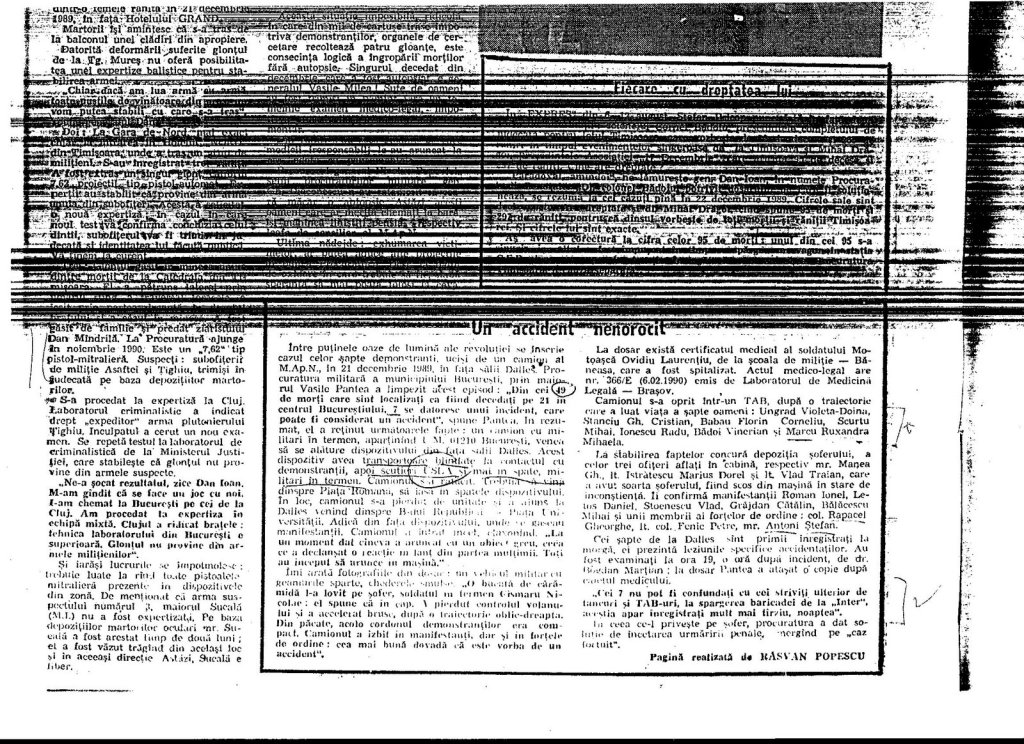













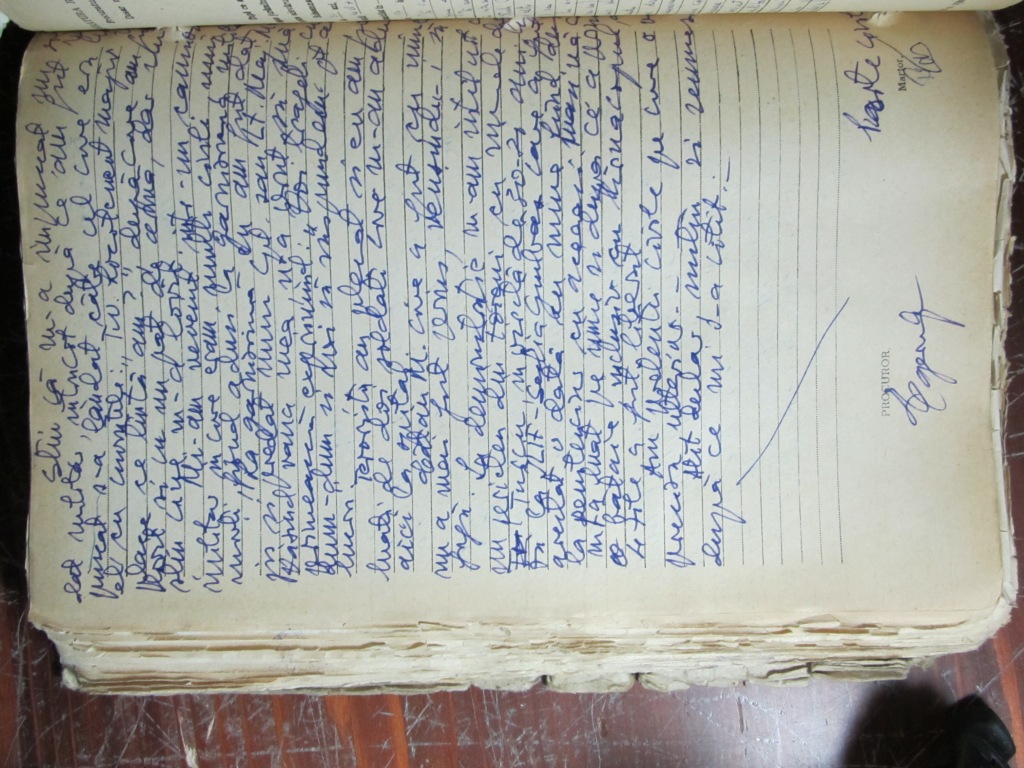


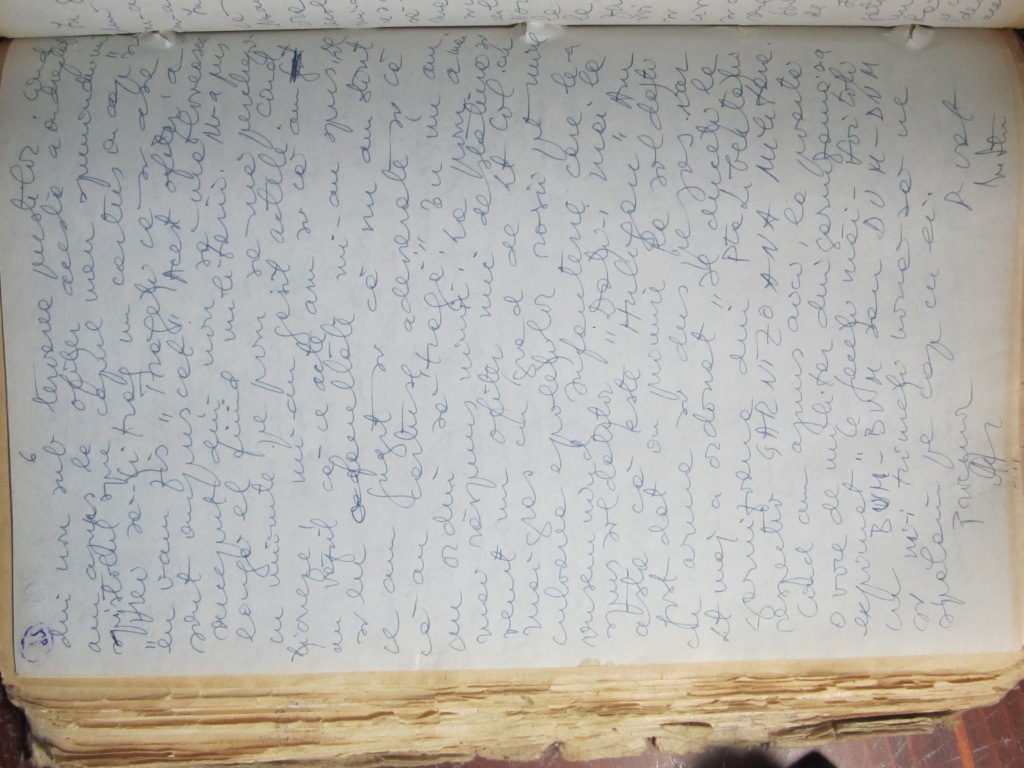
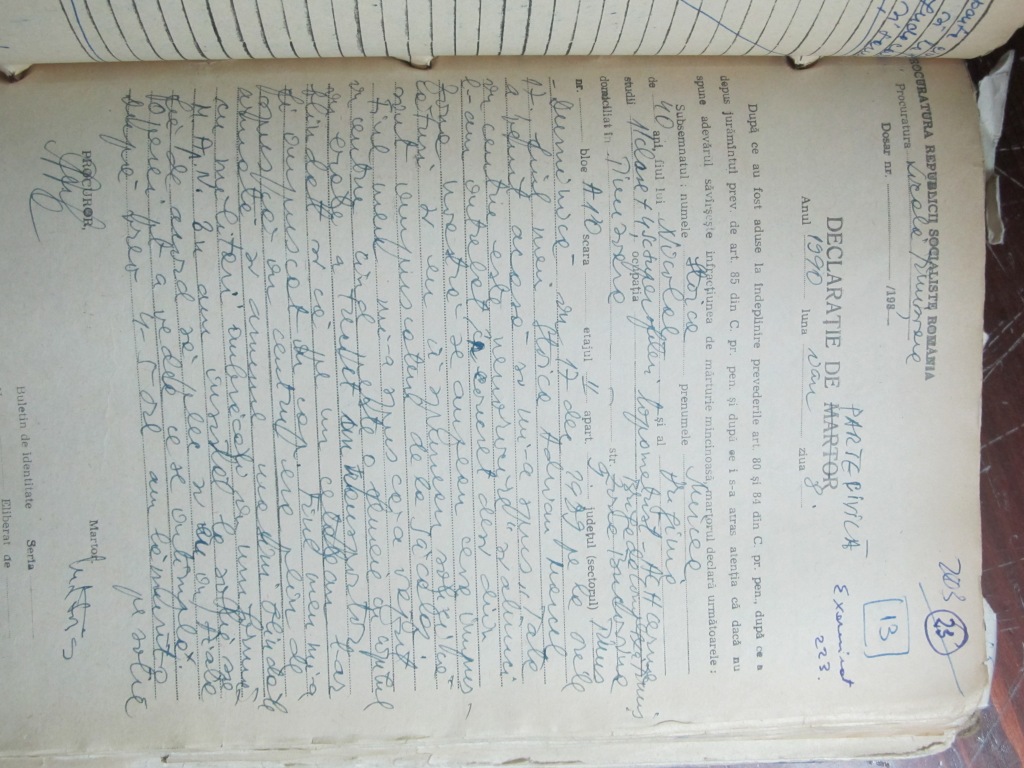
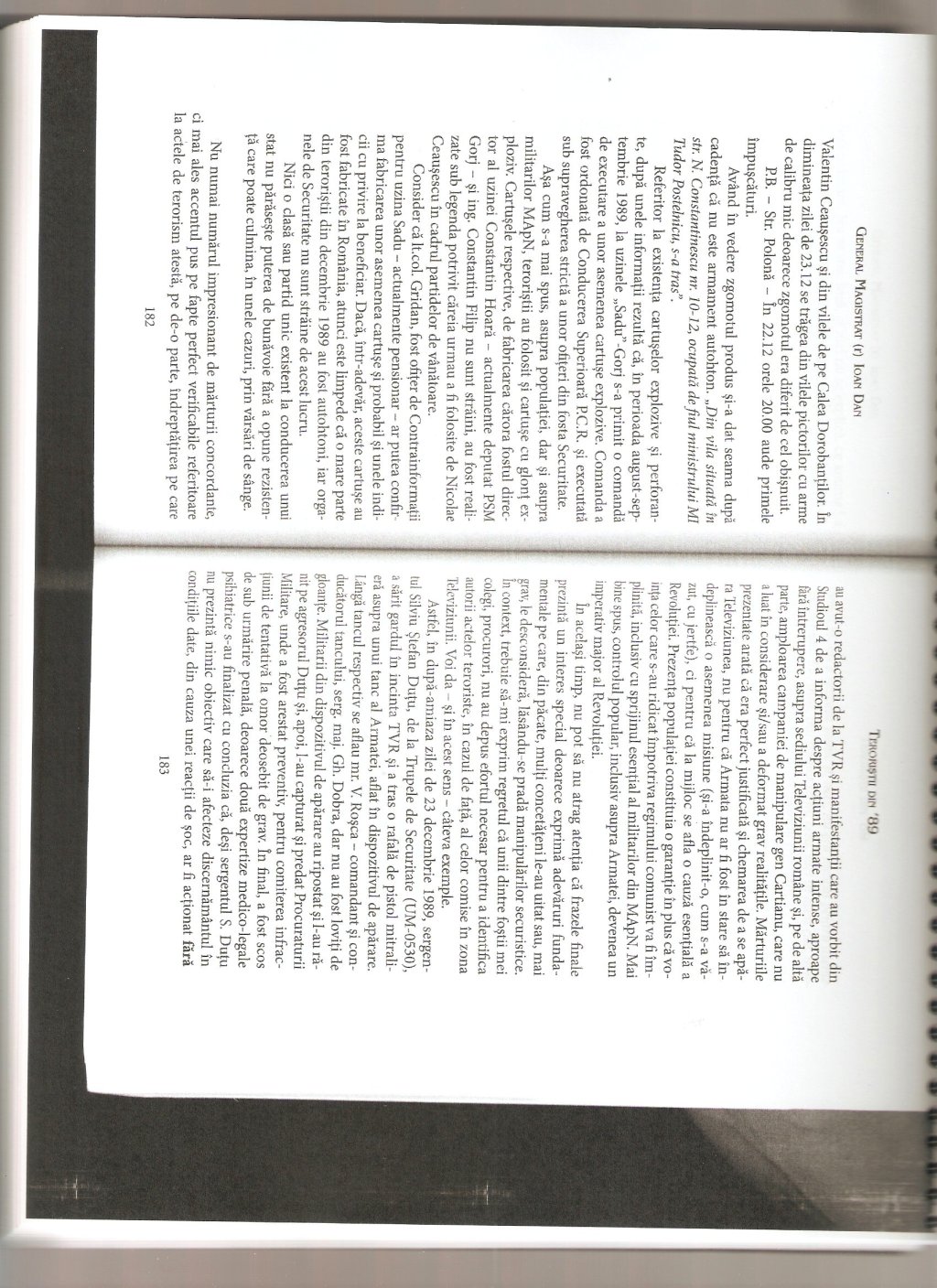





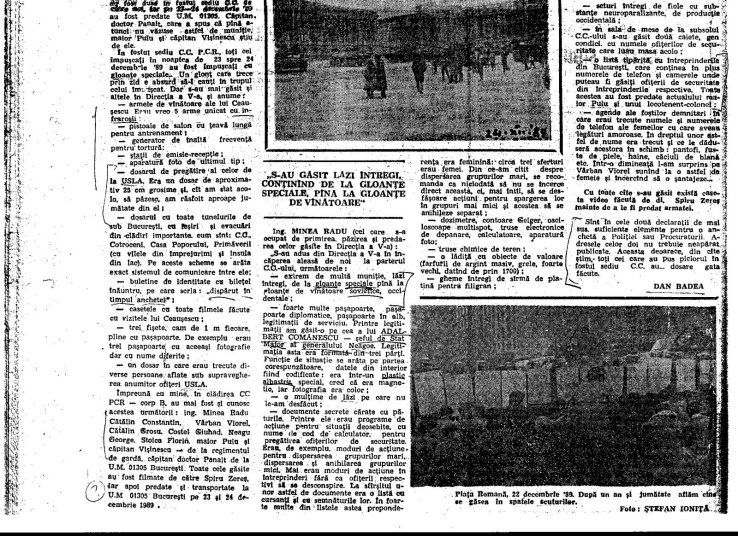





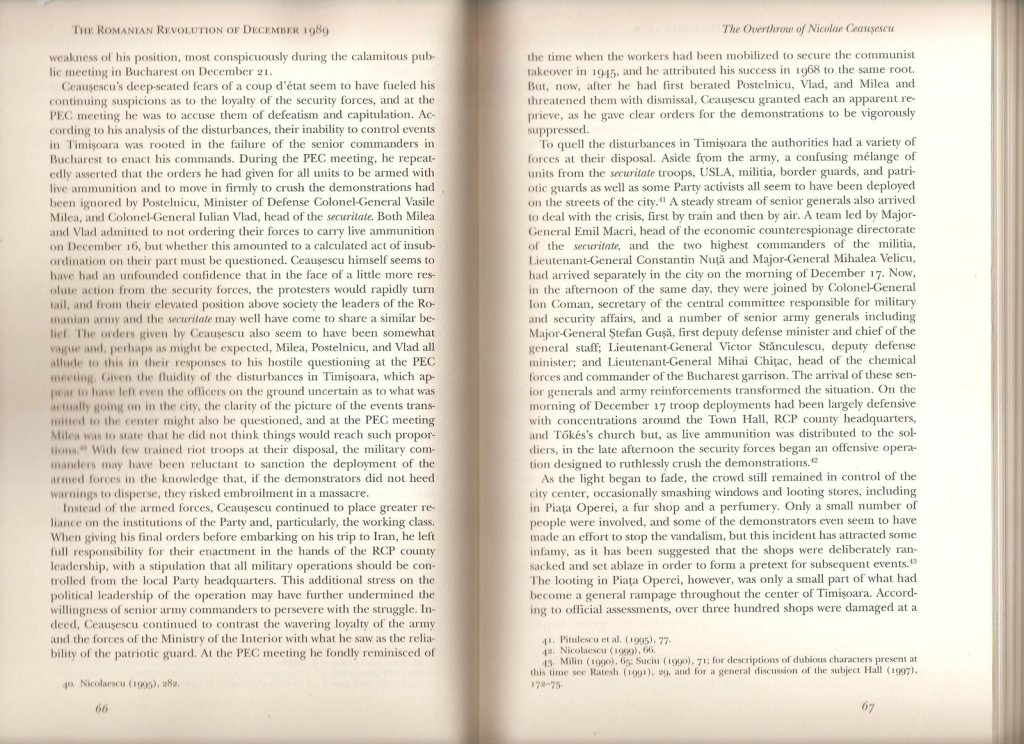



















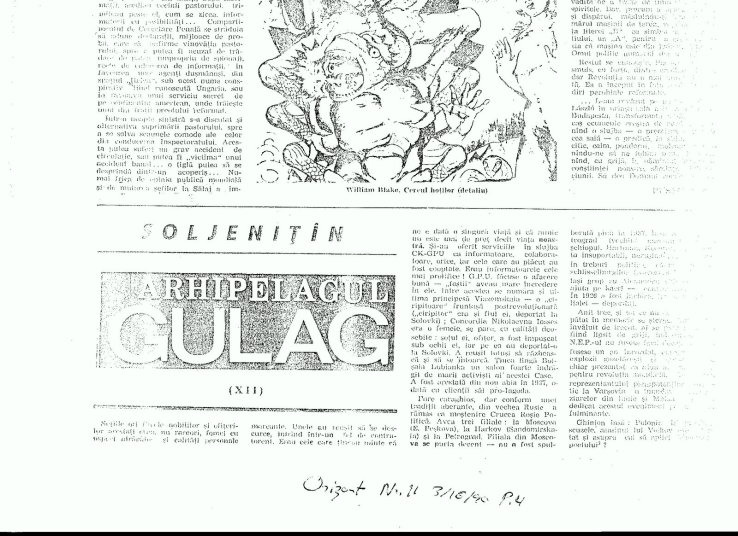


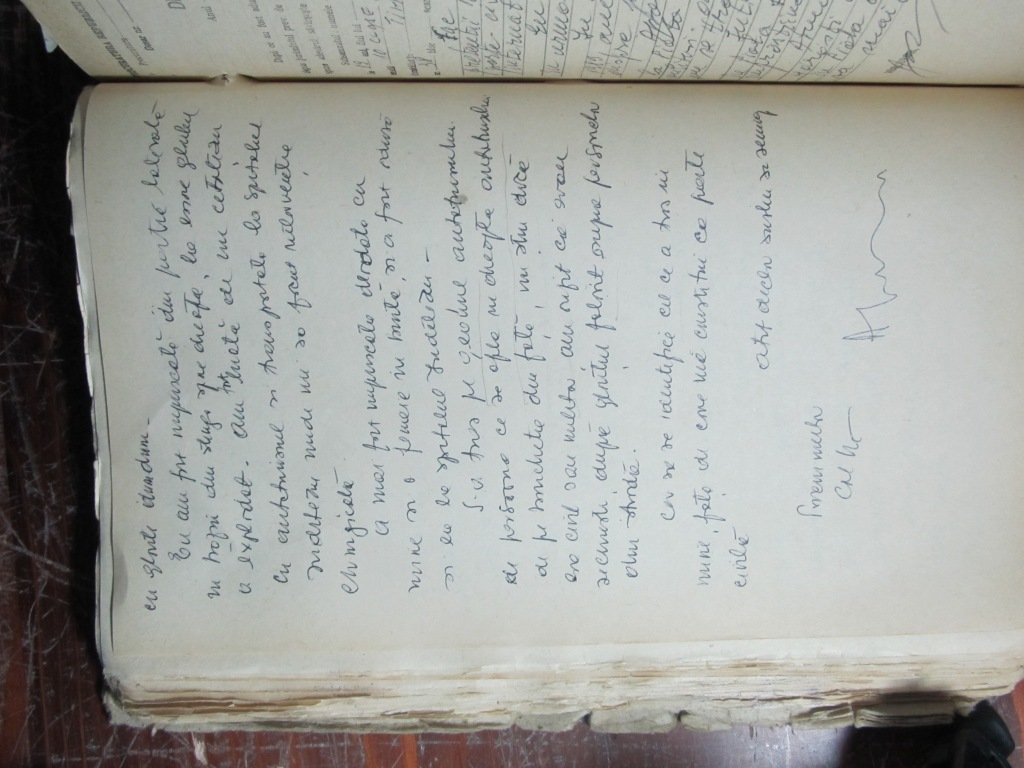
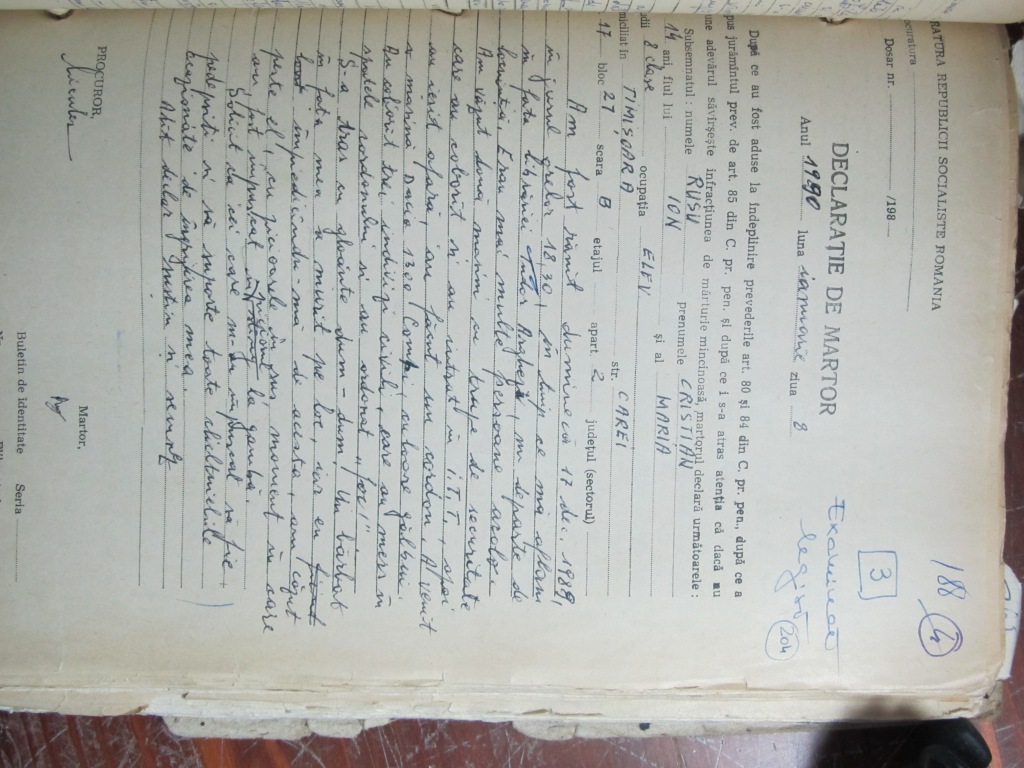

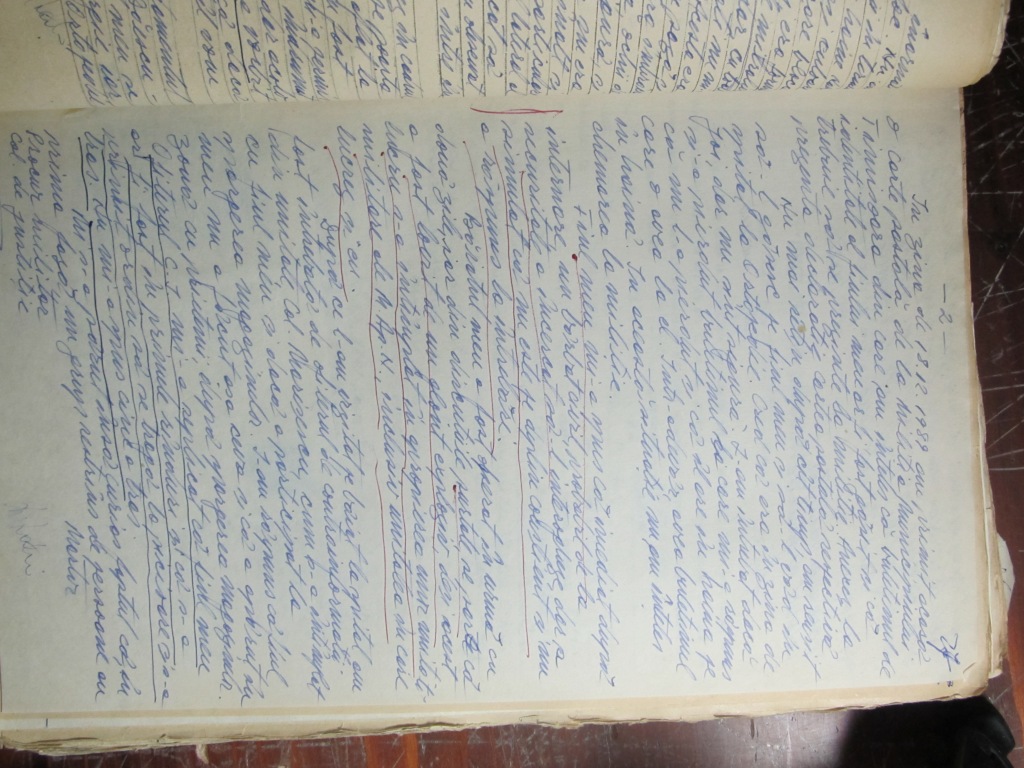
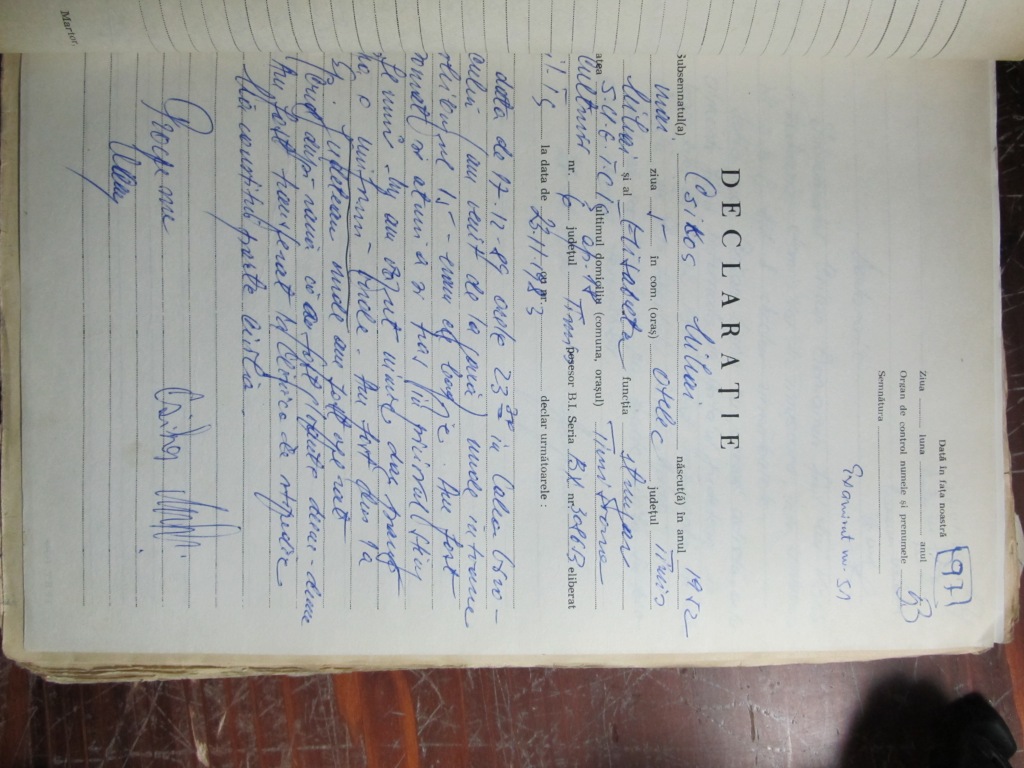
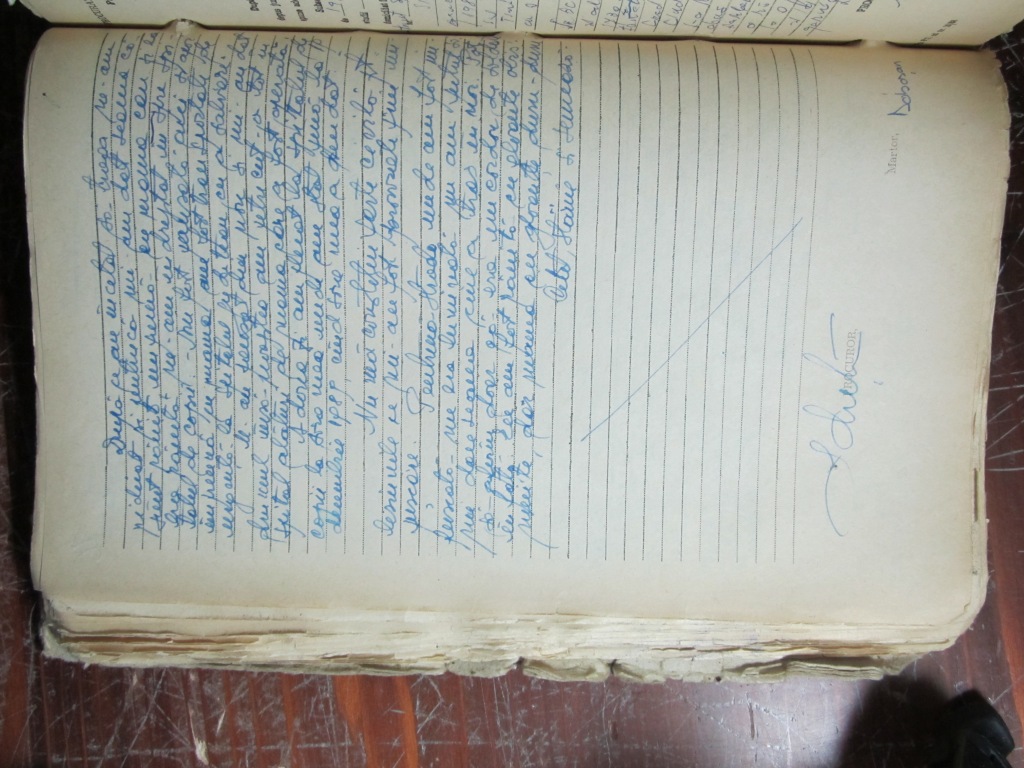
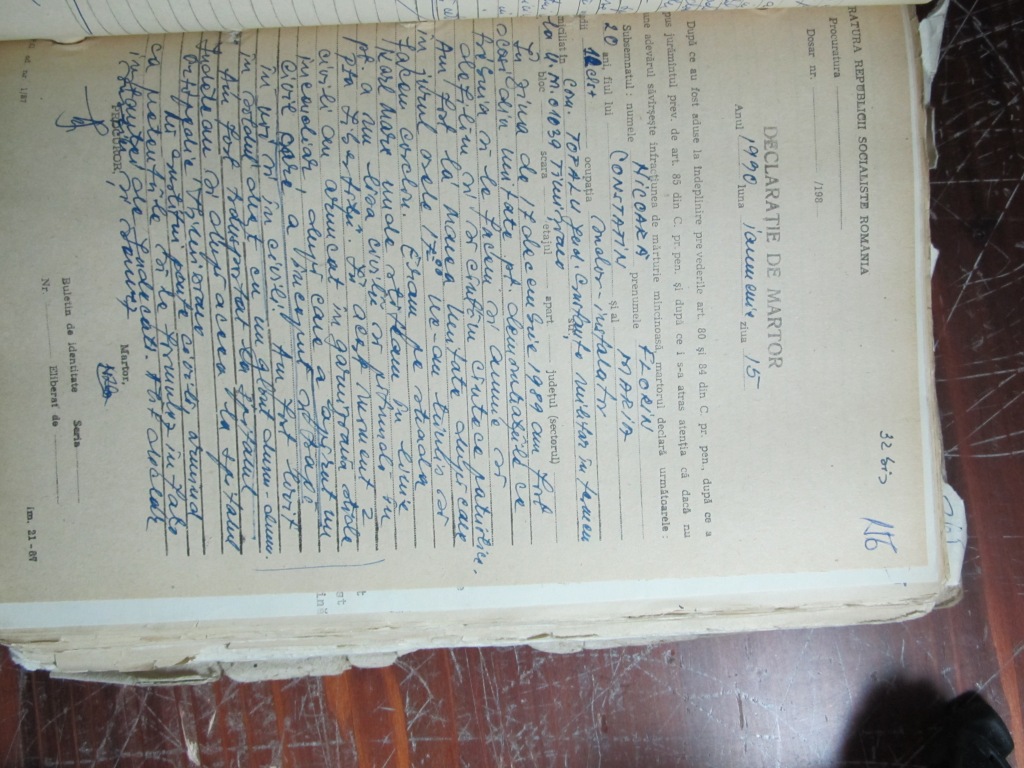
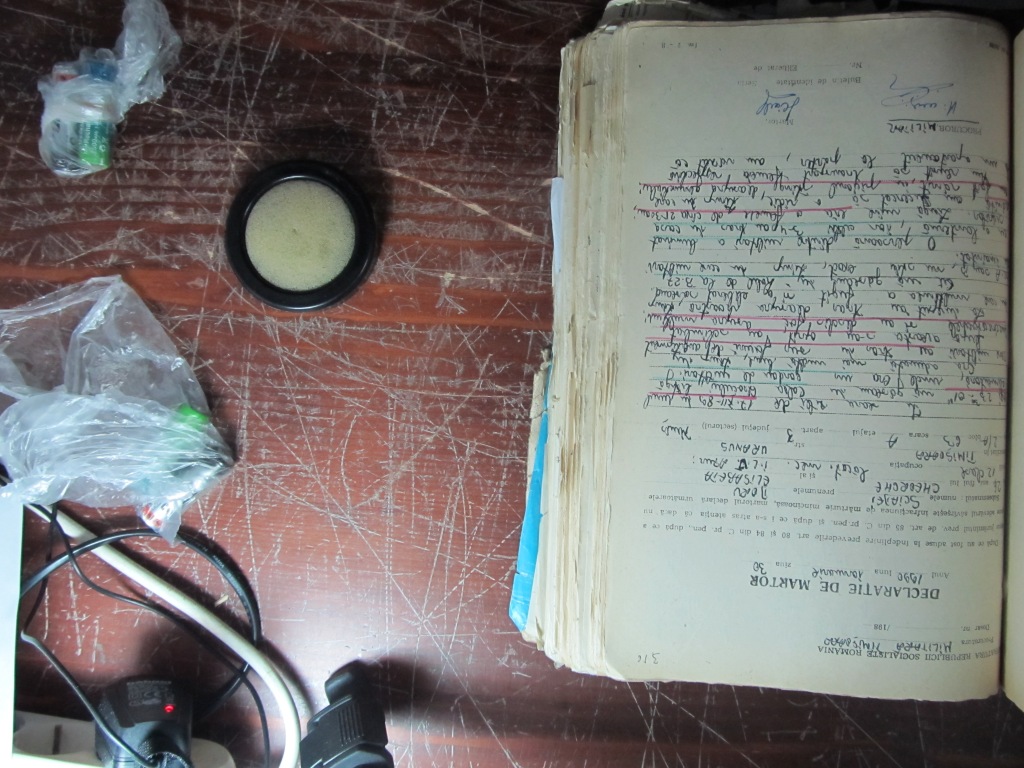


























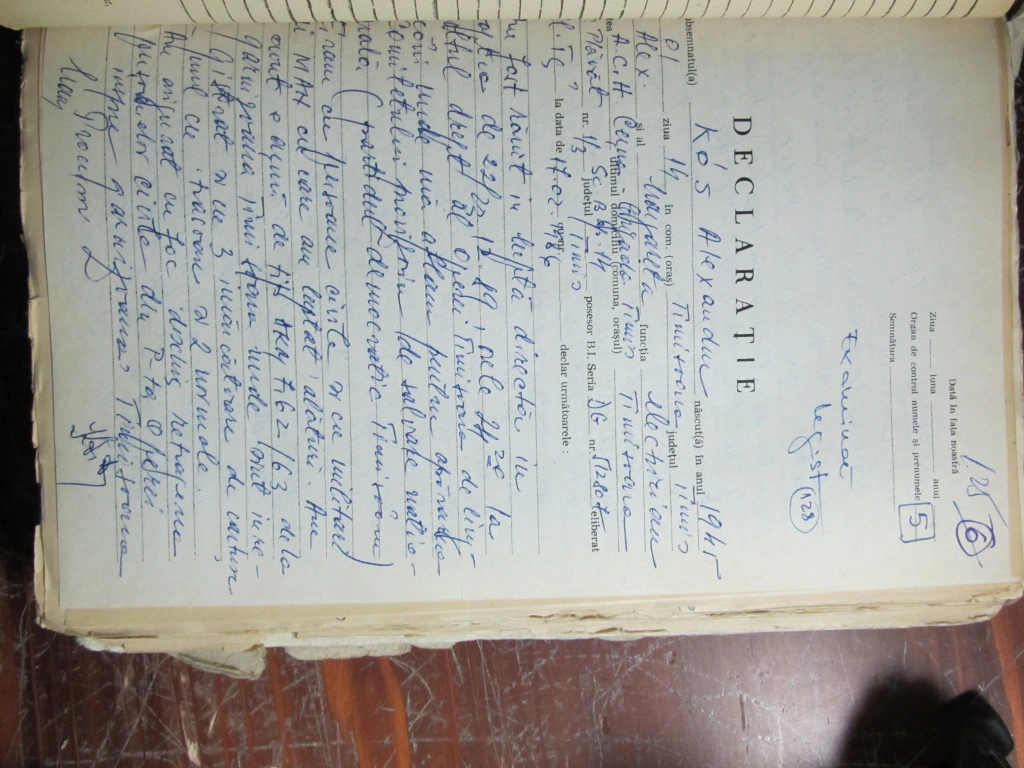
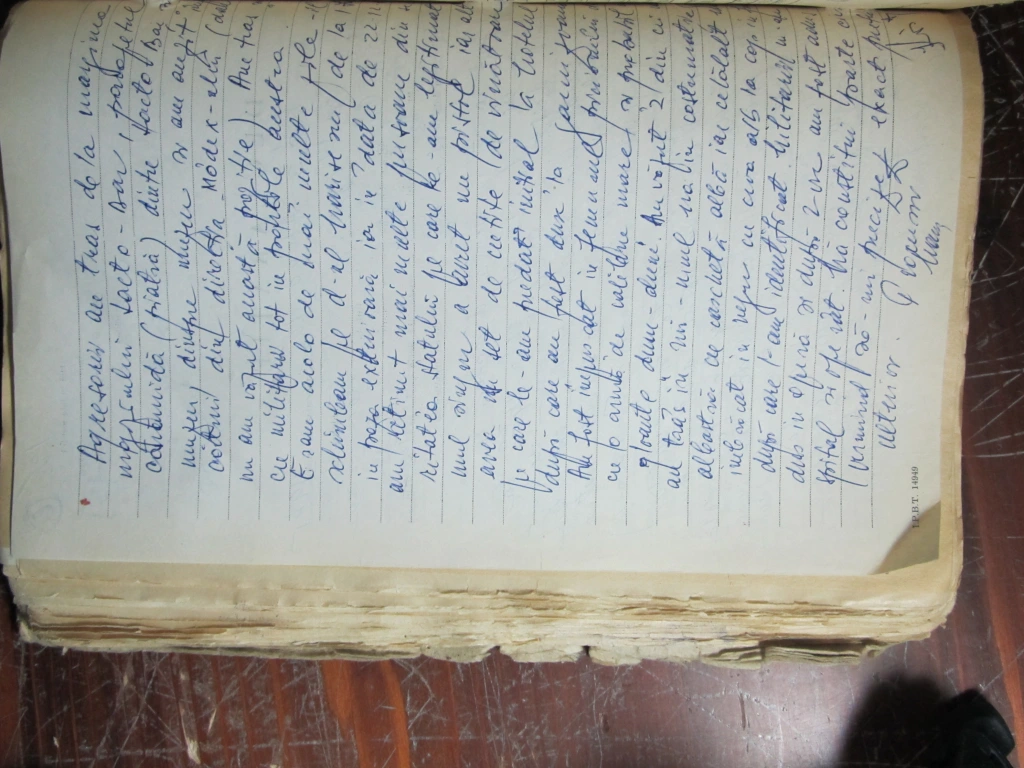

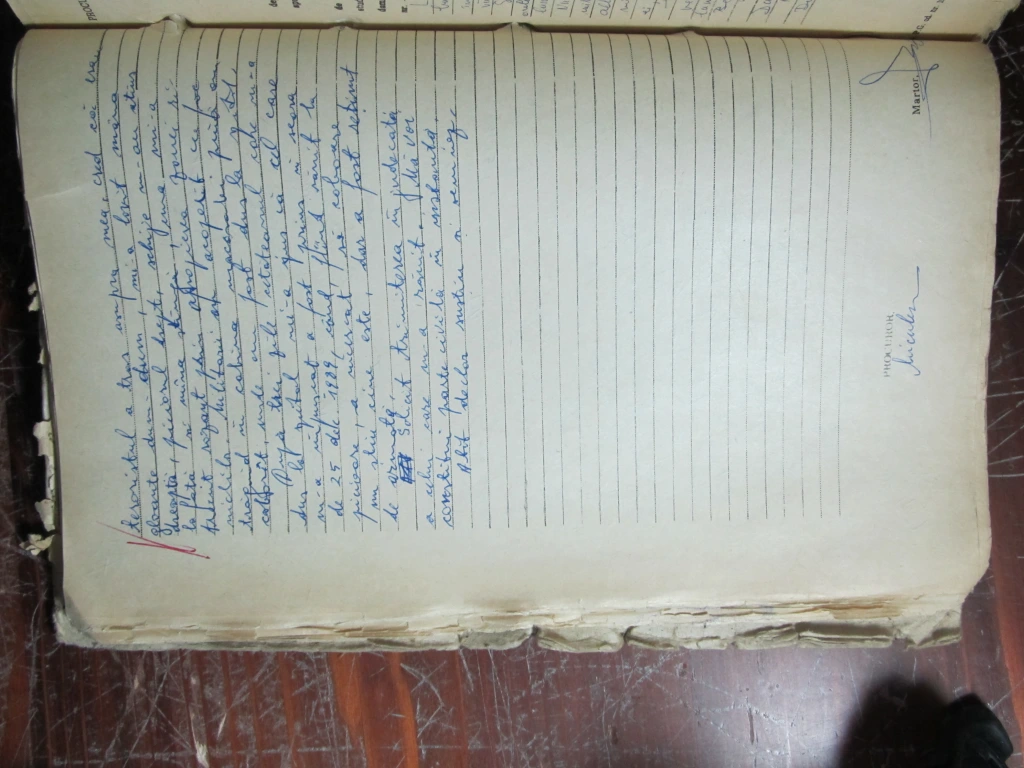
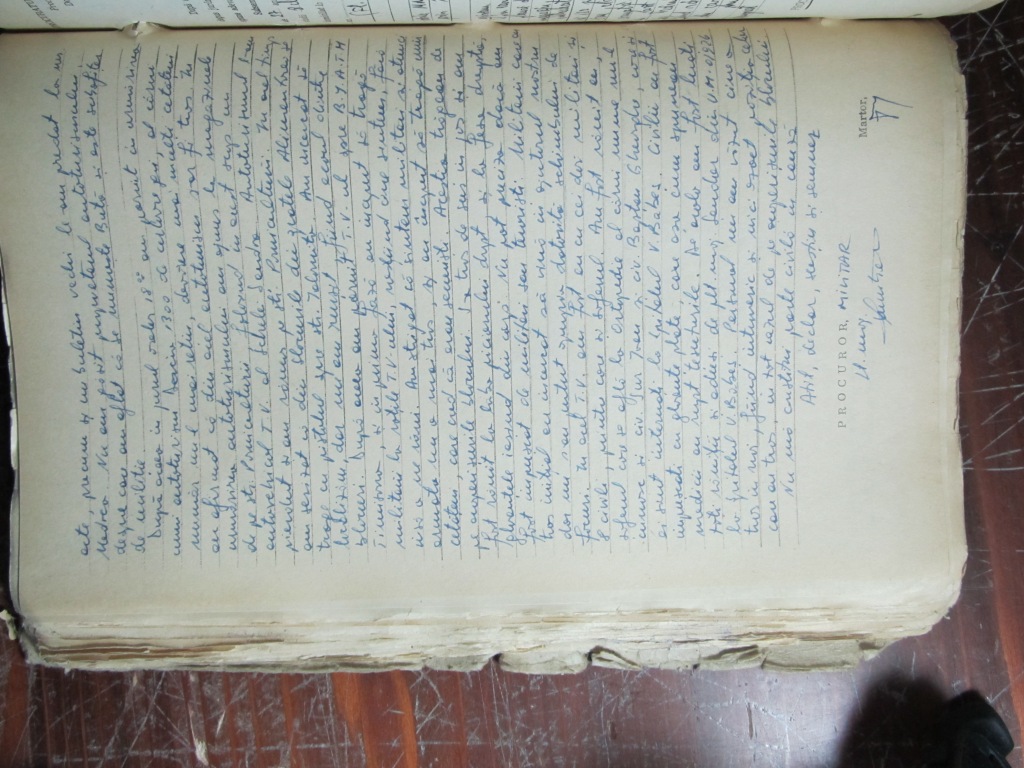
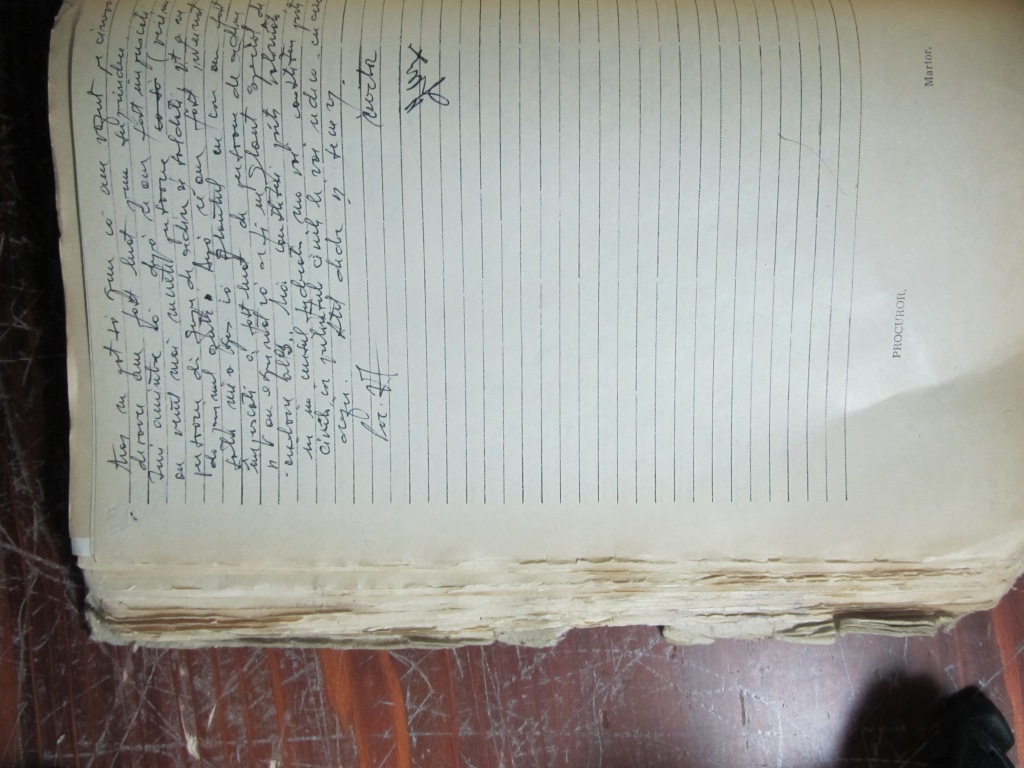
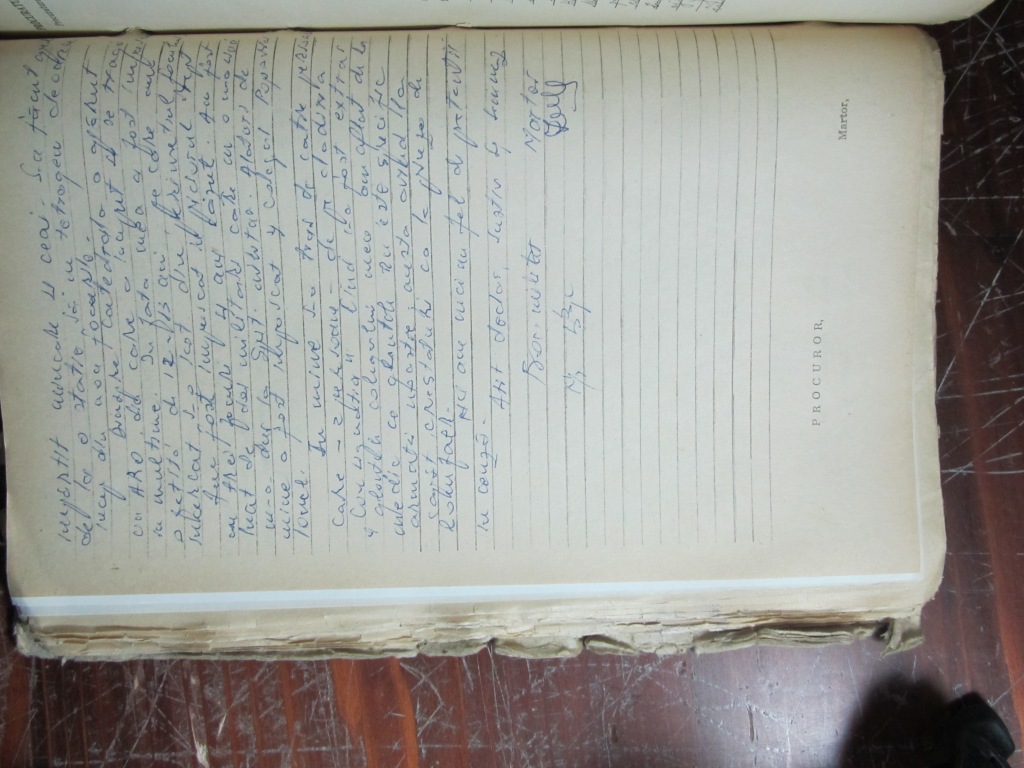

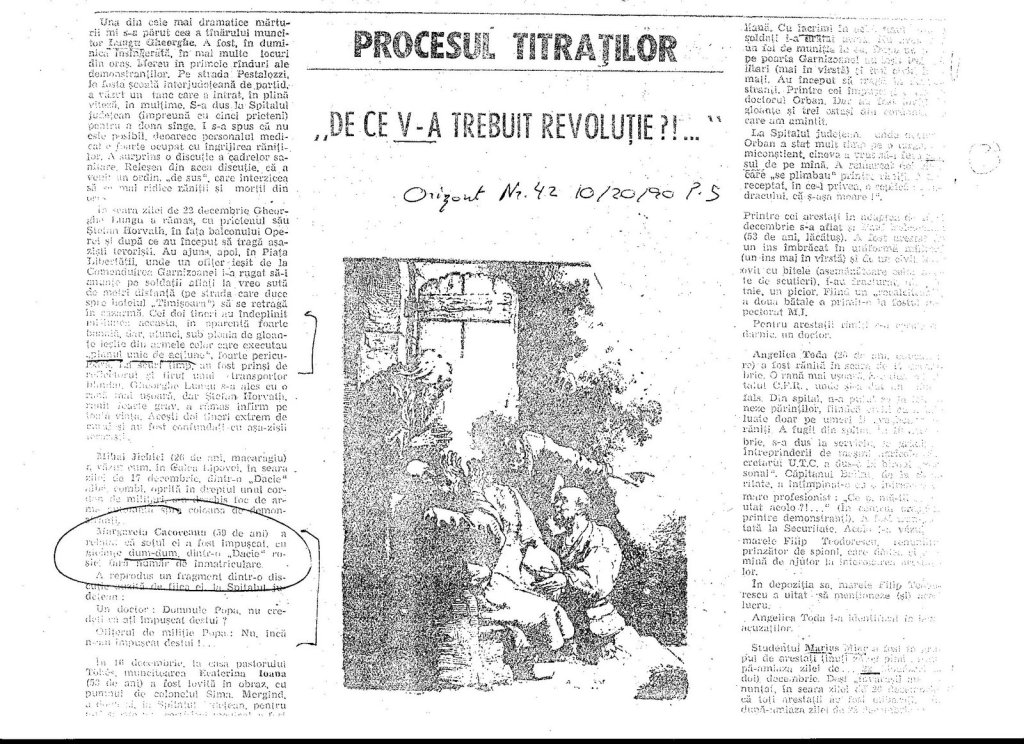
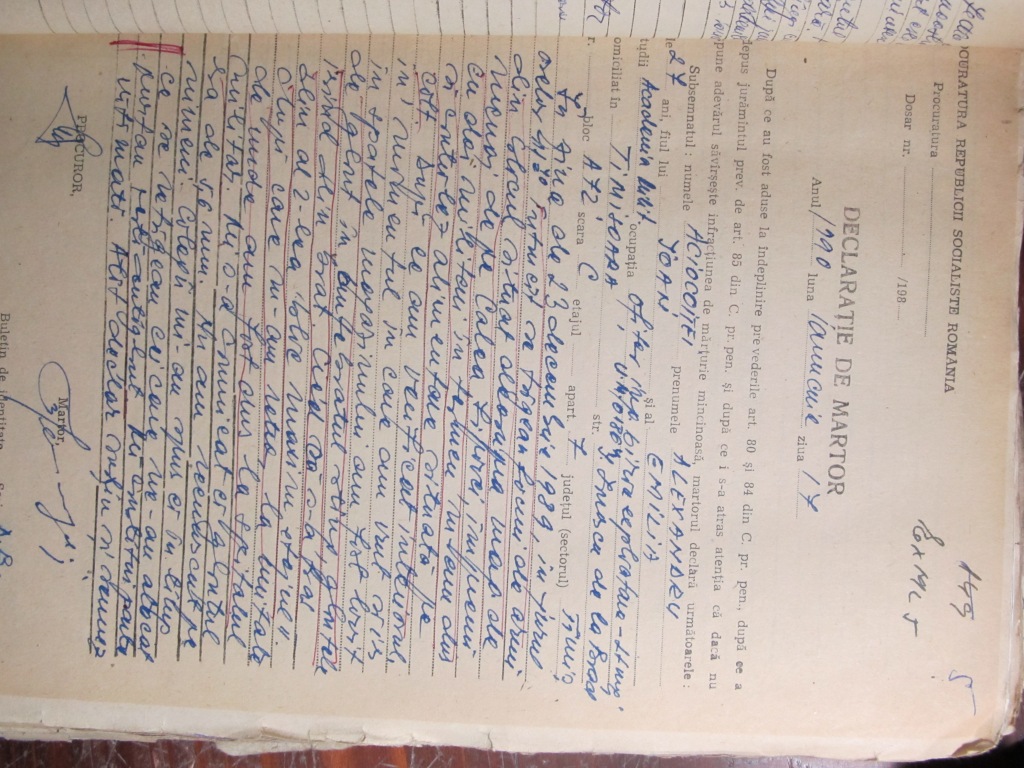


Toatei corpurile delicte au fost adunate si inventariate la Institutul de criminalistica din Bucuresti. Procurorii militari au venit si le-au luat. Au fost duse pe strada Alexandru Sahia, unde era sediul Procuraturii. Voinea care acum se face ca nu stie avea biroul acolo. Alo, se aude!?